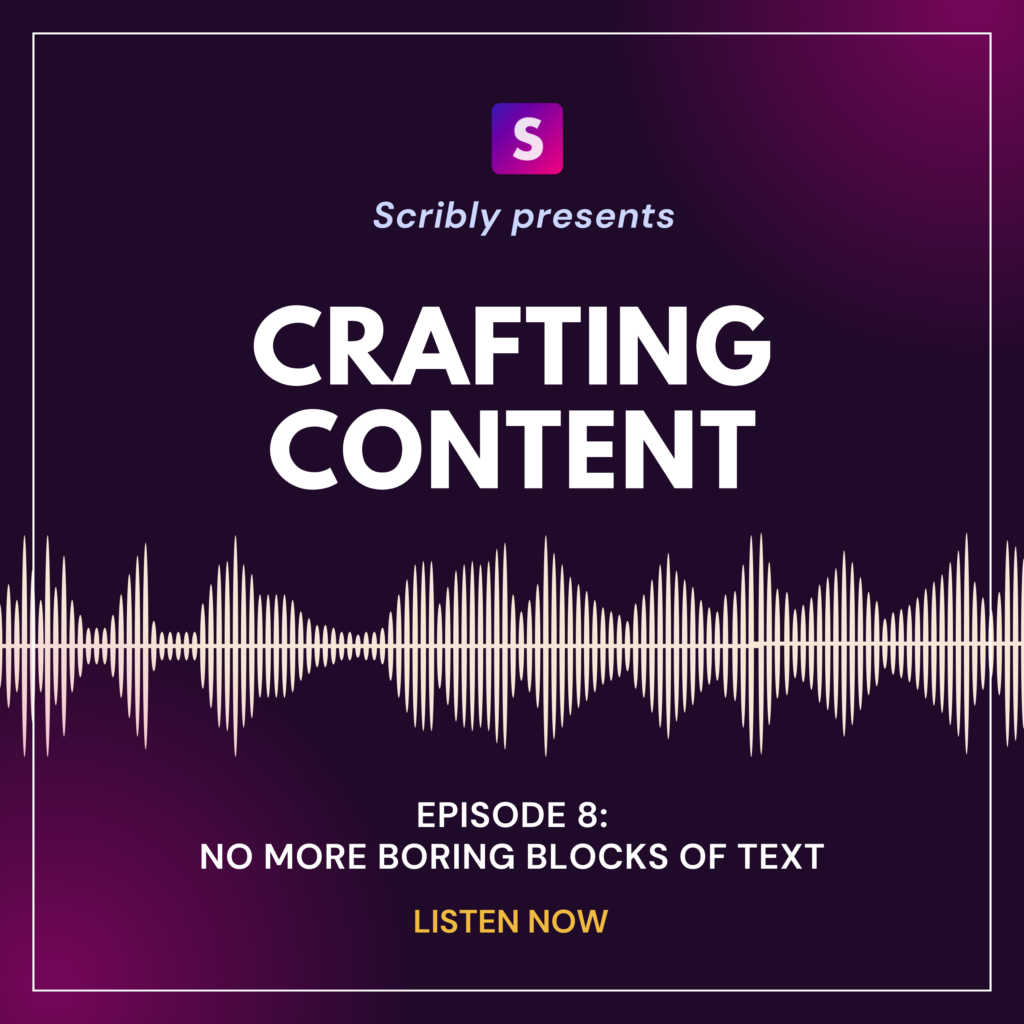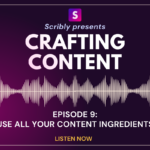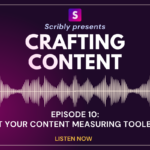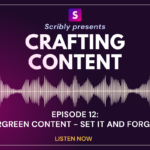Crafting Content, Episode 8 – A content marketing podcast from Scribly
Crafting Content Episode 8: No more boring blocks of text
The eighth episode of Scribly’s “Crafting Content” podcast is here! In this content marketing podcast, we share insights, top tips, and real-world examples to help you develop your content marketing skills.
Continuing on our “common content marketing mistakes” mini-series, today’s topic is about the importance of visuals in content marketing. We discuss how correct formatting can increase reader satisfaction, how images, graphs, infographics, and more can paint a picture worth a thousand words, how pull-out quotes can convey the most important information quickly, and how headers can grab a users attention.

You can listen to the full episode here: Scribly’s Content Marketing Podcast Episode 8: No more boring blocks of text
Episode 8: No more boring blocks of text [transcript]
Taylor: Hello, and welcome back to Crafting Content, the Scribly podcast, where we talk about all things content marketing. We are in the middle of a little series about content marketing mistakes that we see.
Today’s mistake is ignoring visual content.
Joining me again today are my coworkers, Elle and Alex, and you might hear special guest Rigby the dog barking his little head off in the background. If you do, I’m so sorry. but he is persistent.
Elle: He’s an honorary member of the Scribly team.
Taylor: He’s very chatty, unfortunately. So, visual content, why is it such a mistake to ignore it?
Elle: I guess the importance of visual content comes down to audience engagement and keeping people interested and reading what’s on the page. I think people read online content up to twice as fast as written content. If someone sits down to read a book or a magazine, they’ve chosen to perform the act of reading. Whereas when people are reading content online, typically they’re doing research and they’re looking to find information very quickly and they have a much shorter attention span. So, the advantage of visual content is that it’s going to offer that extra bit of engagement to diversify what they’re looking at, to keep their eyes scrolling down the page, and just make it so much more interesting for them to consume.
Alex: I think, particularly when you think about something like social media, a lot of the stuff that people read on there isn’t something they’ve necessarily purposefully sought out. So, it’s not like they’ve sat down and Googled something that they’re looking for. It’s like “Oh, this has cropped up. It looks interesting”. And then you can keep them engaged with visuals. Whereas, as you say, if you’ve purposefully chosen to just read a book, you know what you’re getting yourself in for. It’s just reading a block of text. Whereas if you’re confronted with a web page that is just a block of text, I think most people would probably bounce off that, especially if you’re not very invested in what it is.
Elle: And I guess when we talk about visual content, hopefully the listener is picturing traditional visuals in the sense of images or videos. But I think when it comes down to the written form of content marketing, a good starting place is to talk about the F-shape — the way that people consume content online. So, when we say an F-shape, we mean that people read your title or your headline first — that being the top bar of the f — and then they scroll through and typically read just the headers — which again is the second bar of the f — and then quickly skim through, using either the headers or short bullet points or markers within the copy to find the small piece of information or the small part of the article that they’re actually interested in reading. When we compare reading a newspaper article, which will be just block of text after block of text with a headline and one big image, versus reading a text that is visually made for online reading and fast scroll reading, the importance of formatting is so obvious.
Taylor: Yeah, absolutely. I mean, I know that I definitely do that. I generally will navigate when I’m reading something by the headings and subheadings and then be like “Oh, this is the spot that has the information that I’m looking for”. And then read somewhat more closely that specific section most of the time. And then if it’s interesting, then go back to the beginning and read the rest of it.
Elle: Yeah, interestingly, we had a podcast a few weeks ago about SEO content, but it’s also how crawlers digest the content. So they’ll scroll through and they’ll read the headings first and they’ll read it in priority order. So they’ll read your H1 first and they’ll read all your H2s. Then they’ll read all your H3s. And only then will they read the body of the text. So, the crawler is imitating the way that people consume content online to decide whether or not it’s, I guess, not only relevant but useful to the online reader. so having that format is so important.
Taylor: Beyond formatting, what are some other kinds of visuals that people should be including in their content marketing?
Alex: Well, one thing I was just thinking, Elle, when you were saying about whether the content is useful, I think visuals can be super useful for conveying information. So, things like graphs and charts for one. It’s much easier to see a pie chart or a graph or something than read “Such and such made up x percentage of this in the economy, whereas this was this percentage”. If you just have a nice clean graph, you can get all the information you need as fast as possible. And, yeah, it’s good for illustrating points in the text as well. I suppose with a visual representation of something, or if you’re talking about the biggest car factory in Arizona, you can put a picture of it in there and you don’t have to describe it and expect the reader to think it up themselves. I think they’re really good for not just keeping you engaged, but actually conveying useful information. A picture paints a thousand words, right?
Taylor: No, I definitely agree with that, especially for things that have lots of statistics or data in them. If you can break it up with visuals that pull out the most salient points, and then that will grab people’s attention, and then hopefully they’ll decide “Oh, I want to learn more about why 68% of employers are investing in smart sensors in their office buildings” and then read the more detailed report on it. But visuals are like windows into the house of your content. They let you see in a little bit and see what’s there, and then, you can go inside and see all of it.
Elle: No, I think that’s a really good point because it comes down — and this is maybe the first visual that anyone will ever see — to the leading image that you use. So, when we talk about a website, it might be the picture on your homepage. When we talk about a blog, it might be your header image or your banner image. On a social post, it’s either the one image you post or the first image in a carousel. The visual importance of that acts almost as the hook and it gives enough insights for people to think “Oh, this article is going to be relevant to me” or “I understand what this brand represents because of the type of visuals that they’ve used”. So, it’s definitely a little bit of insight into what you’re going to read next. And, in that sense, the visuals support the wider message.
Taylor: Also, I don’t know if you guys ever do this, but sometimes when I search for things, I go straight to Google images and see if it’s something that I want to understand better. I’ll pick the prettiest graph and then go read that blog post about whatever it is.
Elle: Yeah, I was trying to explain something the other day to someone about the marketing funnel — which we actually talk about in detail in one of our earlier podcasts. Rather than getting them to read a full blog post that detailed everything, I just sent them the graph of what that funnel looked like to get them to understand it instantly. Sometimes words almost over-explain, whereas an image is a nice support. So, if I was using it in a blog post, I might use the image on the left and then the text explaining it on the right, but it does just help people digest that content so much faster.
Taylor: Yeah.
Elle: So, I guess when we’re talking about visuals, one we haven’t touched on yet is video. And I think it’s particularly good for either product demos or if you’ve got a product description on a web page and then you’ve got a video of someone also using it, that helps people understand its benefits so much faster. Or again, you could have it at the end of a blog post with a recap of what to do, or someone showing you the various steps. and in that sense, I guess the text works as your typical study tool. but then the video just offers that little bit of extra human engagement as well.
Alex: It’s nice sometimes to have someone explain something to you rather than just reading it and trying to understand it yourself. It’s quite nice to hear, even if they’re just reading the same text. I think it can definitely help with how much you learn from it or how much you understand it, or how much you can engage with it. If you have an actual person — or I guess an AI voice, increasingly — actually saying it to you in a way, like how information will be conveyed between two people.
Taylor: Yeah, these admittedly are like news outlets, but there are a couple of sites that will let you read the story and also listen to it at the same time, which is not, it’s not visual, but it’s just another way of conveying the information, which can be really valuable. Especially if you don’t want to sit down and read a 1000-word post in that moment. If you have a video with just the key points or the most interesting thing in there, then that can be a great way to pull people in.
Elle: Yes. I guess when we’re talking about visual content in the context of content marketing, we’re just talking about offering readers a different way to consume the written content and to support the message that is being conveyed. Fortunately, the number of tools that allow you to do that is increasing. Does anyone have any — I guess maybe this is a funny way of putting it — favorite types of visuals that they like to use? Either when you’re uploading a post to the Scribly website or to a client’s website to make it stand out, or even to use in the briefs that you submit to writers so that they can better understand the topic and what we’re trying to convey to the reader?
Taylor: I think that, things like flowcharts or infographics can be really helpful, especially if they’re interestingly designed. It’s not something that we do a lot of for Scribly’s content, but we’ve had some clients in the past that have used that visual to break things down or pull out interesting processes that we’re talking about.
Elle: Do you have a particular industry that it works really well for? Sorry if that was a bad question.
Taylor: No, it’s a good question. I just don’t have a good answer.
Alex: I found it really helpful with ecommerce stuff. Talking about sales numbers, engagement, financials, and things like that. I found it really helpful having infographics, graphs, and flowcharts about processes of how you would set up things like that.
Taylor: Yeah. The other one I was going to say is software development. Anything where you’re trying to explain a process — especially if it’s how your company does ecommerce versus how other people do it. Illuminating the differences. I think that can be really valuable.
Elle: My favorite, which you definitely will see if you go onto the Scribly website because I’m usually the one who’s managing that side of things, is a pull-out quote. Love a little pull-out quote. Just something where we’re writing a piece, say a guide to what content marketing is. And the likelihood is we’ll have given a concise — but relatively complex — explanation of what it is. But there’ll be a core sentence which is what people should really take away from it. And I really like to pull that out and make it stand out on the page so that, again, you’re feeding people with priority information through the visual formatting of that page.
Taylor: I love a good stock image.
Alex: Can’t go wrong with a stock image. Yeah.
Taylor: Good old pixels, unsplash. Yeah. What can be hard, if you’re using sites that have royalty-free images for free, is to pick ones that not everybody else has picked as well.
Elle: And I guess that aligns with the brand that you’re using it for as well.
Taylor: Yeah. So what I tend to do, especially for Scribly posts is look for something that’s not a literal image, but can be representational or tangential. You could see that yes, this relates to the topic, but it’s not a picture of a warehouse or whatever. It’s like a picture that connotes teamwork or something like that instead.
Alex: Yeah, sure.
Taylor: Yeah.
Elle: My favorite example of that is, I think, Alex, you wrote an article recently about call-to-actions, and the head image that we used was a woman with a microphone, literally calling people to action. So, rather than it being like a screenshot of an email with a big button on it, this metaphorical image is a lot more powerful.
Taylor: And you can build associations with feelings and stories, as we’ve spoken about in the past. The pictures that you choose have so many layers. So yeah, definitely include visuals in terms of formatting, pictures, infographics, and all that good stuff in your content marketing. They really help.
We’ll be back soon with another episode, where we’ll talk about some more content marketing mistakes as we come to the end of this little mini-series that we’ve been doing. We hope to see you there.
Thank you for listening to Crafting Content, a content marketing podcast from Scribly. You can find more information about what we cover today in our show notes. Scribly is a content marketing agency that helps you boost traffic, generate sales, and increase your bottom line. With our end-to-end service, we take care of everything from content audits and strategy to content creation and management across websites, blogs, socials, and email. We’re a small but mighty team of experienced strategists and marketers who specialize in content creation. If you want to learn more about how Scribly can help your business, please get in touch. You can find more information and send us a message on our website, scriblymedia.com. We’d love to hear from you.




